Over the course of 6 days, Bryn Mawr’s Geology Department traversed a set of rocks that record a complex mountain-building event across northwestern Spain.

Suki Lopez (BMC '15) shows off a Proterozoic granite that was deformed in the collision between modern North America and modern Africa. This granite is the oldest known rock of the Iberian Peninsula.
The Neoproterozoic: Subduction and a Passive Margin
The story of northwest Spain begins ~600 million years ago. Laurentia (modern North America) and Gondwana (modern South America, Africa, India, Antarctica, and others) had recently rifted apart as the supercontinent Rodinia broke apart. The Iapetus Oceanseparated the two continents.
On the northern coast of Gondwana, an ocean plate began subducting, producing melts that rose into the overlying crust and became granites. We observed these granites at the roadside outcrop near Pola de Allande. There, the granite had been foliated and deformed by later tectonism, but it still represents the oldest known rocks of Iberia. The rocks into which these granites intruded have never been found.
As subduction continued during the Neoproterozic, erosion of Gondwana was depositing a thick sedimentary sequence onto the continental margin. Clay-rich shales, sandstones, and limestones deposited onto the continental margin, interbedded with the occasional calc-alkaline volcanic ash from nearby subduction-related volcanism. We observed these sedimentary rocks at the roadcut showing the Precambrian-Cambrian unconformity.

Danyelle Phillips (BMC '14), Storrs Kegel (HC '13) put their hands on the angular unconformity between the Precambrian and Cambrian
The Cambrian: A Passive Margin
During the Cambrian, passive margin sedimentation continued along the northern coast of Gondwana. We saw evidence of this sedimentation at three places along our cross-section:
- The Luna Dam, just outside Barrios de Luna, in the Foreland Fold and Thrust Belt. There, we saw red nodular limestones, shales, and sandstones with cross-bedding from the Middle Cambrian. These layers were tilted to their near-vertical position by the later Variscan Orogeny.
- The Precambrian-Cambrian unconformity roadcut. These layers were later folded and tilted to their near-vertical position by the Variscan Orogeny.
-
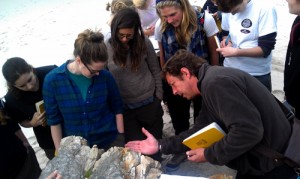
Gabi Gutierrez-Alonso shows the students cleavage planes in the upside-down Cambrian sandstone overturned by a recumbent fold
The upside-down quartz sandstone at Binquereia Beach, in the Fold and Nappe Province, further into the hinterland of the orogeny. This sandstone had upside-down cross-bedding, indicating that it was on the lower limb of a recumbent fold. This giant fold was part of the Mondono Thrust, which formed later in the Variscan.
Taken together, we see that the Cambrian was a time of various marine environments off the coast of Gondwana: limestones, shales, and sandstones deposited on the passive margin of the Iapetus Ocean.
The Ordovician: Rifting of Avalonia

Fern Beetle-Moorcroft (HC '14) and Suki Lopez (BMC '15) point to some feldspar lenses in Ordovician gneisses
Toward the end of the Cambrian, subduction began on the opposite side of the Iapetus Ocean, on the east coast of Laurentia. The subduction was so intense that it pulled the whole Iapetus Ocean toward Laurentia, including Gondwana. The northern edge of Gondwana tore off, forming the long, narrow terrane of Avalonia (~480 Ma). Between Avalonia and Gondwana, a mid-ocean spreading center opened up, pushing Avalonia away and spreading open a new ocean: the Rheic Ocean.
The rifting event caused heating and melting in the Gondwana foreland. Granitic melts intruded into Gondwana. During the Variscan, these granites would be metamorphosed into the granitic gneisses we saw at Xilloy Beach, where the giant white alkali feldspar crystals formed lenses in the layered gneiss. The original granites were emplaced around 490 million years ago, near the Cambro-Ordovician boundary.
Meanwhile, the continental margin of Gondwana was still passive, and still collecting sediments – this time in the Rheic Ocean, not the Iapetus. We saw many Ordovician-age sedimentary rocks during this trip:
- The Armorican Quartzite that we observed at the Luna Damn near Barrios de Luna was deposited during this time, in the shallow sea between Avalonia and Gondwana.
-
The beautifully-deformed phyllites at Porcia Beach were originally deposited as mudstones and shales in the Rheic during this time. These rocks were further toward the hinterland of the Variscan, and so underwent more intense metamorphism and folding as they were thrust eastward by the Mondonco Thrust Fault.
- The granulites we saw on the beach near Carino, in the Cabo de Ortegal Complex at the end of the trip, also formed during this time, but not as part of Gondwana. These sediments were part of the Avalonia passive margin, and went riding off with Avalonia toward Laurentia. They would eventually be reunited with Gondwana during the Variscan.
The rifting of Avalonia also caused volcanism along the north coast of Gondwana. At ~456 million years ago, a supervolcano erupted off the coast of Gondwana, induced by the rifting event. The massive ashfall covered all of the coast of Gondwana, and can now be found as a thick kaolinite (clay) layer throughout Ordovician-age sediments in Europe. We observed this kaolinite layer in the Cambro-Ordovician sequence at the Luna Damn near Barrios de Luna. There, the kaolinite layer had been compacted by the quartzite that sandwiched it, but was still more than a foot thick.
The Silurian: Death of the Iapetus
By ~420 million years ago, 60 million years after it had split off from Gondwana, Avalonia docked at Laurentia, another in a set of minor orogenies that collectively would make the Appalachian Orogeny. This docking officially closed the Iapetus Ocean, and now only the Rheic remained between Gondwana and Laurentia.
At about the same time, subduction began off the coast of Gondwana, pulling the Rheic Ocean closed and Laurentia closer in.
The Devonian: Rapid Closing of the Rheic

Storrs Kegel (HC '13) and Sarah Glass (HC '14) show off a chevron fold in Devonian-age shales within the Alba Syncline
Early in the Devonian, sedimentation continued along the Gondwana margin, even as the Rheic was closing. We saw evidence of this in several outcrops:
- In the Corresillas Conglomerate, we saw Devonian-age sandstones, rich with crinoids fossils. These must have formed early in the Devonian, along the continental margin.
- In the Alba Syncline sequence, we saw a series of deep marine shales and shallow marine quartzites that had been deposited on the Gondwana continental margin, and were later folded and metamorphosed during the Variscan.
Around 390 million years ago, Laurentia subducted the mid-ocean spreading center in the Rheic. This rapidly sped up the closing of the ocean, and Gondwana and Laurentia drifted toward each other faster.

Danyelle Phillips (BMC '14) examines black shales at the Devonian-Carboniferous boundary in the Alba Syncline
The Early Carboniferous: The Variscan Orogeny
In the early Carboniferous, sedimentation continued as usual on the margin of Gondwana, as Laurentia continued to pull the Rheic closed. We saw evidence of this in the Alba Syncline sedimentary sequence, where the Devonian-Carboniferous boundary shows up as a fissile layer of black slate. In that sequence, we saw red nodular limestone laid down at the beginning of the Carboniferous, followed by more shale.
Around 325 million years ago, Gondwana and Laurentia began colliding. The western portions of Gondwana were affected first, as the collision forced giant fold and thrust belts up eastward onto Gondwana. You can watch a video of this process on Gabi’s YouTube Channel.
We saw abundant evidence of this in our trip:
- In the hinterland, we saw evidence of huge thrust belts that folded, faulted, and moved continental margin sediments hundreds of kilometers inland. The complex folds we observed in the gray phyllites at Porcia Beach formed during this time.
- Further toward the collision zone, we saw the limbs of a giant recumbent fold, propelled by the Mondonoco Thrust Sheet. This sheet alone shortened material by 180 km along the continental margin.
- Further from the collision zone, the Alba Formation was folded into the Alba Syncline.
- The Precambrian-Cambrian boundary we observed was folded during this time.
In addition to folding and thrusting the Gondwanan rocks, the Variscan Orogeny produced a suite of granitic rocks and smashed an ophiolite sequence up into the suture between Gondwana and Laurentia. We saw evidence of this in several places near the suture:
- The tectonic melange near Espasante
- A piece of Avalonia, left over from the collision, in the granulites near Carino
- The eclogites of Cabo de Ortega
- Harzburgites representing sub-oceanic mantle
- Deformed sheeted dikes
The Late Carboniferous: Oroclinal Bending
By the end of the Carboniferous, the mountains produced by the collision were shedding sediments. We saw evidence for this in the Corresillas Conglomerate, which formed during this time of cobbles from nearby mountains thrust up during the first phase of the Variscan.

Fern Beetle-Moorcroft (HC '14) shows a conglomerate clast that has been fractured during the oroclinal bending event.
The collision had more subtle effects than just pushing up dramatic thrust sheets. As the continental margin shortened and more and more Gondwanan rock piled up, the pile began to weigh down the crust, just like a bowling ball placed in a blanket will dimple the blanket downward. The result was a deep basin inland of the collision zone – the foreland basin.
During this time, marine water filled the foreland basin along Gondwana. There, a thick sequence of carbonates precipitated, forming the rocks that would eventually become the Picos de Europa Mountains.
Late in the Variscan Orogeny, the rocks of Northwest Spain experienced an oroclinal bending event: the area was rotated 90 degrees and compressed again, forming thrust sheets at right angles to the original Variscan thrust sheets. The overprinting of these two sets of thrusts produced the crazy folds of the Ponga Province, and the second set of thrusts pushed the limestones of the Picos de Europa Mountains up into the relief we saw.
Ultimately, the oroclinal bending event produced the Iberian-Armorican Arc, a continent-scale arc of mountains. You can watch a video of the oroclinal bending process at Gabi’s YouTube Channel.
The oroclinal bending event also produced a series of granites. As the bending proceeded, the inner part of the arc thickened past the point of stability, and the underlying lithosphere delaminated. Hot asthenosphere rushed up into the lower crust, producing melts that would become the post-orogenic granites of Northwest Spain. You can watch a video of this process on Gabi’s YouTube Channel.
The Carboniferous to Jurassic: Pangaea
The Variscan was one of several orogenies that assembled the supercontinent Pangaea. For ~170 million years, the mountains of Northwest Spain sat in the middle of the supercontinent. Then, about 200 million years ago, the Atlantic Ocean began opening, and separated Northwest Spain from North America again.
The Cretaceous: An Inland Seaway
After the Atlantic had opened, marine waters invaded the coast of Northwest Spain, depositing the limestones that we observed near Atapuerca. Eventually, these limestones formed the caves in which were found the earliest evidence of hominids in Europe. We saw evidence for these processes at the caves near Atapuerca, including Sima de Elefante, site of the oldest European hominid.
Fall 2012: An Amazing Trip!
Gabriel Gutiérrez-Alonso and Arlo Weil, thank you for an amazing field trip!


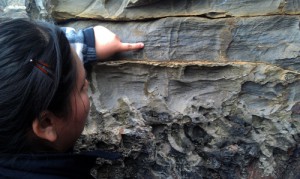

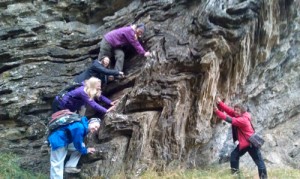






















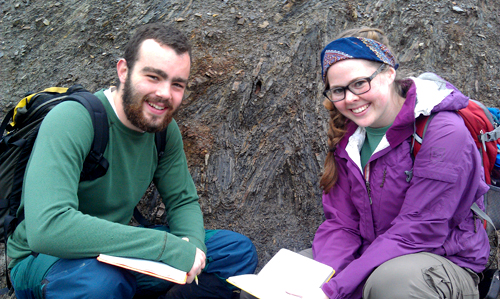
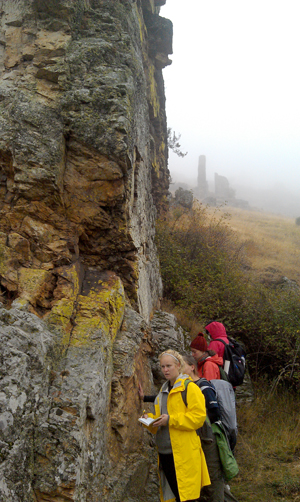
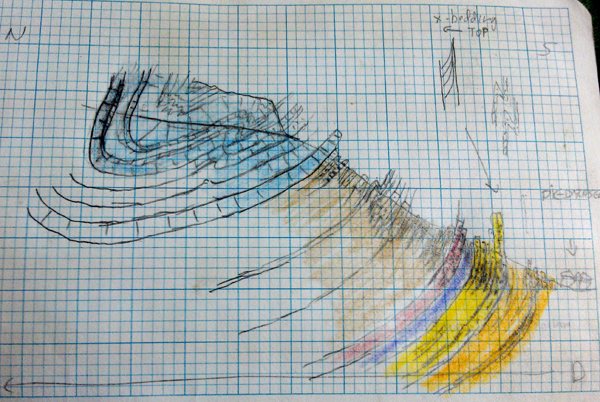








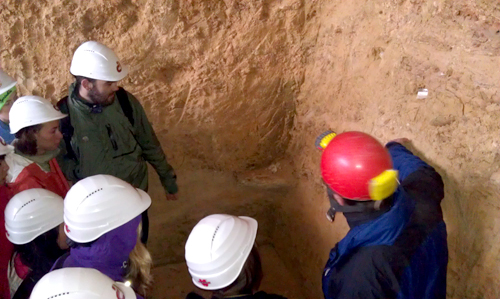
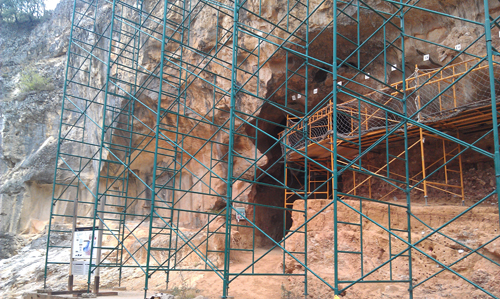
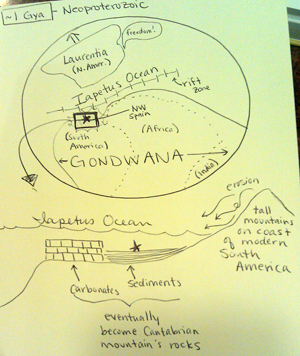
 ~600 million years ago: Subduction begins.
~600 million years ago: Subduction begins.
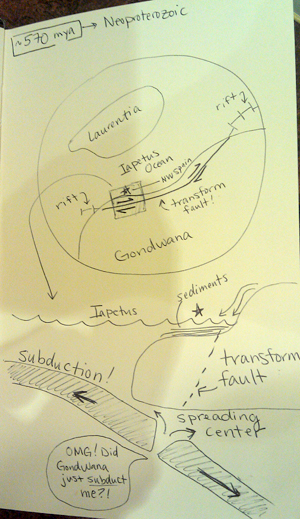
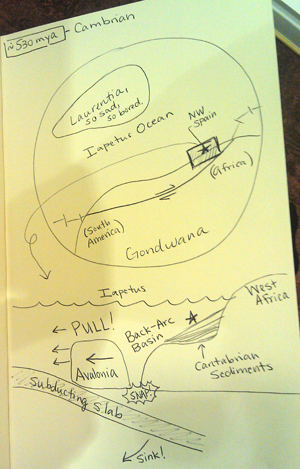

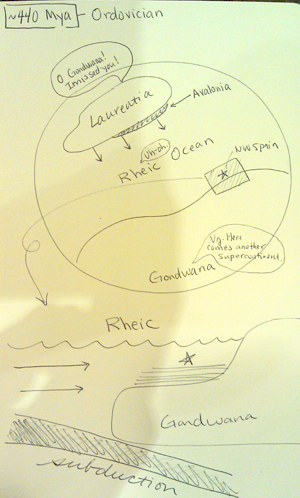
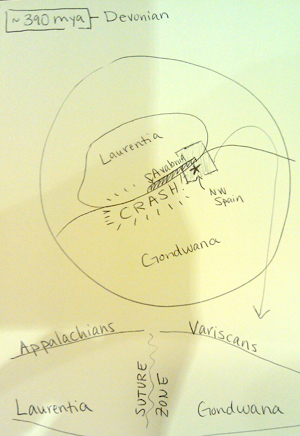 ~390 million years ago: Variscan Orogeny begins.
~390 million years ago: Variscan Orogeny begins.